ESP AUDI A5 COUPE 2010 Repair Manual
[x] Cancel search | Manufacturer: AUDI, Model Year: 2010, Model line: A5 COUPE, Model: AUDI A5 COUPE 2010Pages: 360, PDF Size: 84.39 MB
Page 199 of 360
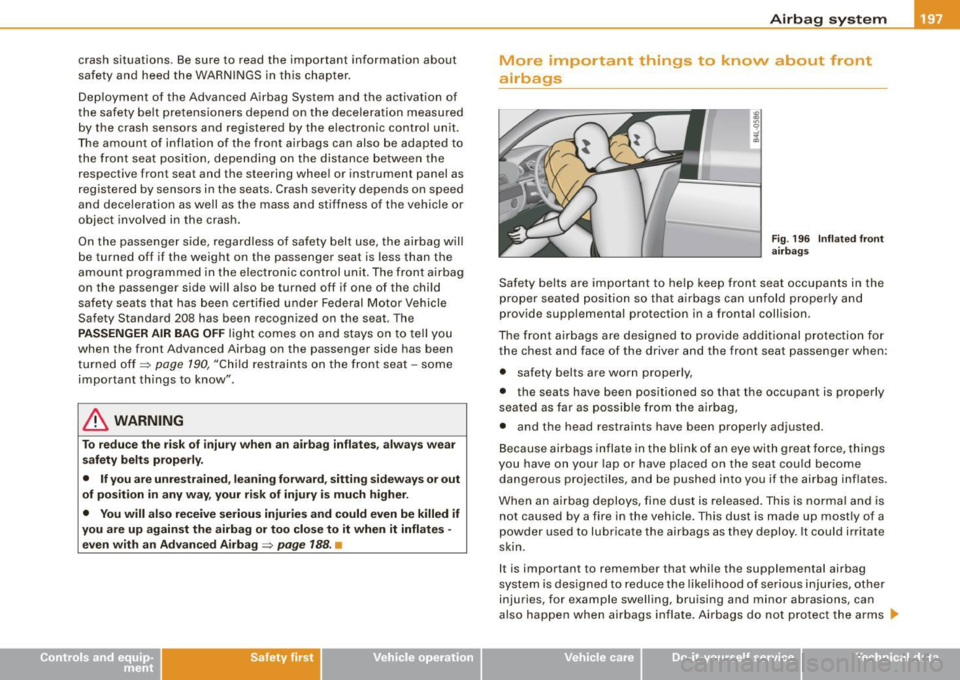
crash situations. Be sure to read the important information about
safety and heed the WARNINGS in this chapter.
Dep loyment of the Advanced Airbag System and the activation of
the safety be lt pretensioners depend on the deceleration measured
by the crash sensors and registered by the electronic control un it.
The amount of inflation of the front airbags can also be adapted to
the front seat position, depending on the distance between the respective front seat and the steering whee l or instrument panel as
registered by sensors in the seats . Crash severity depends on speed
and deceleration as well as the mass and stiffness of the vehicle or
object involved in the crash.
On the passenger s ide, regardless of safety belt use, the airbag w ill
be turned off if the weight on the passenger seat is less than the
amount programmed in the elec tronic control unit. The front airbag
on the passenger side wi ll also be turned off if one of the child
safety seats that has been certified under Federal Motor Vehicle
Safety Standard 208 has been recognized on the seat. The
PASSENGER A IR BAG OFF light comes on and stays on to tel l you
when the front Advanced Airbag on the passenger side has been
t urned off=>
page 190, "Child rest raints on the front seat-some
important things to know".
& WARNING
To reduce the risk of injur y when an airbag infl ate s, a lways wear
safety belt s properly.
• If you are unr estr ained , leaning forward , sitting sideways or out
of po sition in any way , your ri sk of injury is much hig her.
• You will al so rece ive seriou s injuries and could even be killed if
you are up ag ainst the airbag or too clo se to it when it infl ate s -
even wi th an Advan ced Airb ag =>
page 188. •
Safety first
Airbag sy ste m
More important things to know about front
airbags
F ig . 196 I nfl at ed front
airba gs
Safety belts are important to help keep front seat occupants in the
proper seated position so tha t airbags can unfold proper ly and
provide supplementa l protection in a fronta l collision.
The fron t airbags are designed to provide addit ional p rotection for
the chest and face of the driver and the front seat passenger when:
• safety belts are worn properly,
• the seats have been positioned so that the occupant is properly
seated as far as p ossi ble from the a irbag,
• and the head restraints have been properly adjusted .
Because airbags inflate in the blink of an eye with grea t force , things
you have on your lap or have p laced on the seat cou ld become
dangerous projectiles, and be pushed into you if the airbag inflates .
When a n airbag deploys, fine d ust is released . This is norma l and is
not caused by a fire in the vehicle. This dust is made up mostly of a
powder used to lubrica te the airbags as they d eploy . It could irri tate
skin.
I t is important to remember that while the supplemental airbag
system is designed to reduce the likel ihood of serious injuries, othe r
injuries, for example swelling, bruising and minor abrasions, can
a lso happen when airbags inflate . Airbags do no t pro tect the arms •
Vehicle care I I irechnical data
Page 200 of 360
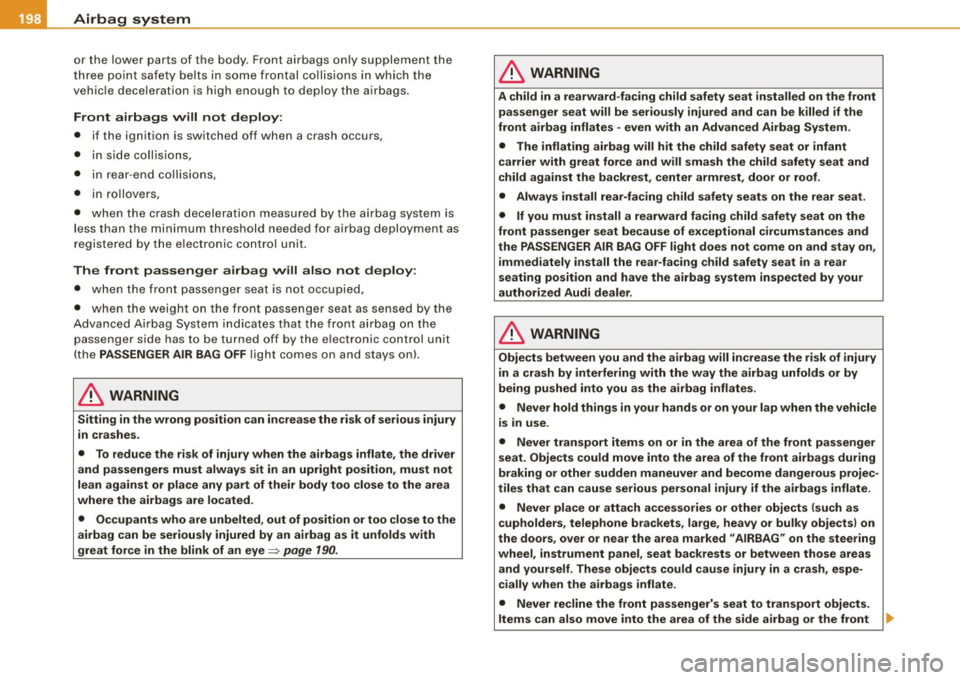
-L~A:::..:,: ir:....: b:!..::: a~g L.:: s:1y :...:s::..: t~ e:.: m:...:...:.. ________________________________________________ _
or the lower parts of the body. Front airbags only supp lement the
th ree p oint safe ty belts in som e front al co llis ions in which the
vehic le dece leration is h igh enou gh to deploy the a irba gs.
Front airbags will not deploy:
• if the ignition is switched off when a crash occurs,
• i n sid e collis io ns,
• i n rea r- e nd collisi ons ,
• in ro llovers,
• when th e c ras h de celerat io n measur ed by the a irba g system is
less than the minimum threshold needed for a irbag deployment as
r egi stere d by th e ele ctro nic con trol uni t.
The front passenger airbag will also not deploy :
• when th e fr ont pass enger seat is no t occupi ed,
• when the weight on the front passenger seat a s sensed by the
A dvanced A irbag Syste m indica tes tha t the fr ont air bag o n the
passenger side has to be turned off by the e lectronic cont rol unit
(t he PASSENGER AIR BAG OFF li gh t comes o n and s tays o nl.
& WARNING
Sitting in the wrong position can increase the risk of serious injury
in crashes .
• To reduce the risk of injury when the airbags inflate , the driver
and passengers must always sit in an upright position , must not
lean against or place any part of their body too close to the area
where the airbags are located.
• Occupants who are unbelted , out of position or too close to the
airbag can be seriously injured by an airbag as it unfolds with
great force in the blink of an eye=> page 190.
& WARNING
A child in a rearward-facing child safety seat installed on the front
passenger seat will be seriously injured and can be killed if the
front airbag inflates -even with an Advanced Airbag System .
• The inflating airbag will hit the child safety seat or infant
carrier with great force and will smash the child safety seat and
child against the backrest, center armrest , door or roof.
• Always install rear-facing child safety seats on the rear seat.
• If you must install a rearward facing child safety seat on the
front passenger seat because of exceptional circumstances and
the PASSENGER AIR BAG OFF light does not come on and stay on, i mmediately install the rear-facing child safety seat in a rear
seating position and have the airbag system inspected by your
authorized Audi dealer .
& WARNING
Objects between you and the airbag will increase the risk of injury
in a crash by interfering with the way the airbag unfolds or by
being pushed into you as the a irbag inflates .
• Never hold things in your hands or on your lap when the vehicle
is in use.
• Never transport items on or in the area of the front passenger
seat. Objects could move into the area of the front airbags during
braking or other sudden maneuver and become dangerous projec
tiles that can cause serious personal injury if the airbags inflate .
• Never place or attach accessories or other objects (such as
cupholders, telephone brackets , large, heavy or bulky objects) on
the doors , over or near the area marked "AIRBAG" on the steering
wheel , instrument panel , seat backrests or between those areas
and yourself . These objects could cause injury in a crash , espe
cially when the airbags inflate .
• Never recline the front passenger's seat to transport object s.
Items can also move into the area of the side airbag or the front ..,
Page 201 of 360
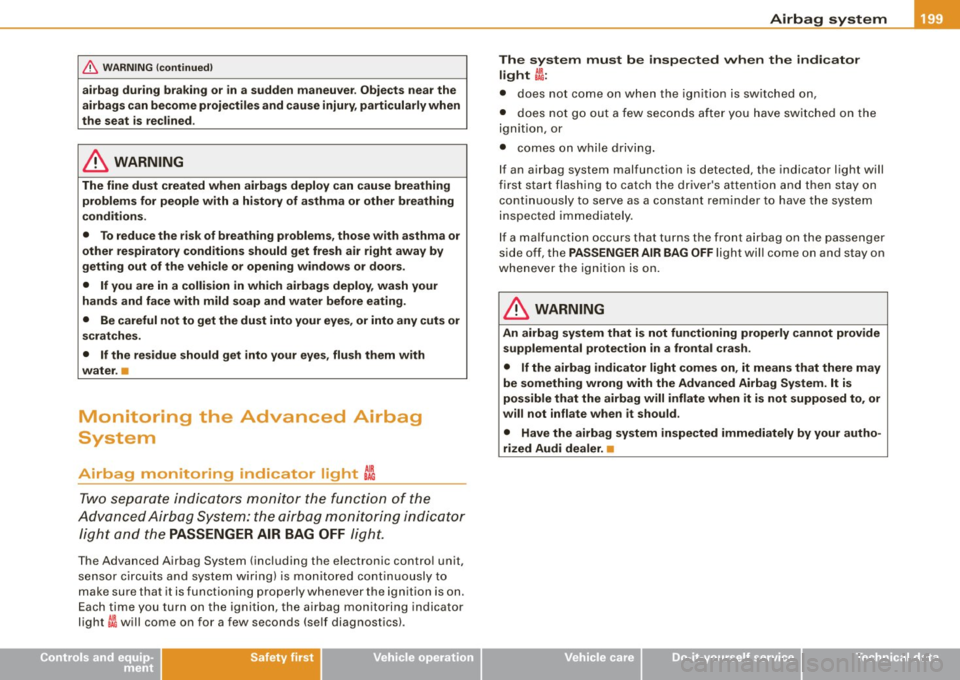
__________________________________________________ A_ i_ r _b _a...; g::- s_ y=--- s_t _e _m __ lffllll
& W ARNING (continued )
airbag dur ing braking or in a sudden maneuver . Objects ne ar the
airbags can become proje ctile s and cau se injury , particularly when
the seat is reclined .
& WARNING
The fine dust created when airbags deploy can cause breathing
p roblems for people with a history of asthma or other breathing
c onditions .
• To reduce the risk of breathing problems , those with asthma or
other respir atory cond itions should get fresh air right away by
getting out of the vehicle or opening windows or doors.
• If you are in a collision in which airbags deploy, wash your
hands and face with mild soap and water before eating.
• Be careful not to get the dust into your eyes, or into any cuts or
scratches.
• If the residue should get into your eyes , flush them with
water .•
Monitoring the Advanced Airbag
System
Airbag monitoring indicator light t~
Tw o separate indicators monitor th e funct ion of the
Adva nced A irbag Syst em : the a ir b ag mon itor in g i ndicator
l ig ht an d the
PASSENGER AIR BAG OFF light.
The Advanced Airbag System (including the electronic control unit,
s en sor cir cu its a nd sys tem wiring) is mon itored co ntinuous ly to
make sure that it is functioning properly whenever the ignition is on.
E ac h tim e you turn on th e ig niti on, the ai rbag monito ring ind icator
light
t~ w ill come on for a few seconds (se lf diagnostics) .
Controls and equip ment Safety first
Vehicle operation
The system must be inspected wh en the indicator
light ~:
• does not come on when the ignition is switched on,
• does not go ou t a few sec ond s a fter you have swi tc hed on the
ignition, or
• comes on while d riv in g.
I f an airbag system malfunction is detected, the indicator light will
fi rst sta rt fla sh ing to catch the d rive r's atten tion an d t hen stay on
cont inuously to serve as a constant reminder to have the syst em
inspected i mmedia tely.
If a mal funct ion occurs that tu rns the fro nt a irbag o n th e passe nger
side off, the PASSENGER AIR BAG OFF light will come on and stay on
whe neve r the ig nit ion is on.
& WARNING
An airbag system that is not functioning properly cannot provide
supplemental protection in a frontal crash .
• If the airbag indicator light comes on , it means that there may
be something wrong with the Advanced Airbag System. It is
possible that the airbag will inflate when it is not supposed to , or
will not inflate when it should .
• Have the airbag system inspected immediately by your autho
rized Audi dealer . •
Vehicle care Do-it-yourself service Technical data
Page 205 of 360

_______________________________________________ .=_A ::_ i :.:.r ~b ~a:=.; 9!:!...: S~ y[: s~ t~ e:::_ m ~ --""
& WARNING (continued )
• Always make sure that the side airbag can inflate without inter
ference :
- Never install seat covers or replacement upholstery over the
front seatbacks that have not been specifically approved by
Audi.
- Never use additional seat cushions that cover the areas
where the side airbags inflate.
- Damage to the or iginal seat covers or to the seam in the area
of the side airbag module must always be repaired immedi
ately by an authorized Audi dealer.
• The airbag system can be activated only once. After an airbag
has inf lated , it must be replaced by an authorized Audi dealer or
qualified technician who has the technical information , training
and special equipment necessary .
• The airbag system can be deployed only once . After an airbag
has been deployed, it must be replaced with new replacement
parts designed and approved especially for your Audi model
version. Replacement of complete airbag systems or airbag
components must be performed by qualified workshops only .
Make sure that any airbag service action is entered in you r Audi
Warranty
& Maintenance booklet under AIRBAG REPLACEMENT
RECORD .
• In accidents when an airbag is deployed , the vehicle battery
separates the alternator and the starter from the vehicle electrical
system for safety reasons with a pyrotechnic circuit interrupter.
-Work on the pyrotechnic circuit interrupter must only be
performed by a qualified dealer -risk of an accident!
- If the vehi cle or the circuit interrupter is scrapped, all appli
c able safety precautions must be followed .
Controls and equip ment Safety first Vehicle operation
<£' For the sake of the environment
U
ndep loyed airbag modu les a nd p retens ioners mi ght be c lassified
as Perch lorate Mate rial -sp ecia l handling may apply, see
www .dtsc.ca.gov/ haza rdous waste/perc hlorate. W hen the vehicle or
parts of the restraint system including airbag modules safety be lts
w it h pre ten sio ne rs are scrapped, a ll appl ica ble l aws and re gula
tions must be observed. Your authorized Audi dealer is familiar with
t hese re qu irements and we rec om men d th at you h ave yo ur dealer
perform this service for you. •
Other things that can affect Advanced Airbag
performance
Changing the vehicle 's suspension system can change the way that
t he Adva nced Airb ag Sys te m per form s in a crash . For e xamp le,
u sing ti re -rim combinations not approved by Audi, lowering the
ve hicle , c hangi ng th e s tif fness of the sus pension , in cluding the
springs, suspension struts, shock absorbers etc. can change the
forc es that are meas ured by the ai rbag se nso rs a nd se nt to t he ele c
tronic control unit. Some suspension chan ges can, for examp le,
i nc rea se t he for ce le v e ls mea sur ed by the se nso rs and make th e
ai rbag system dep lo y in cras hes in w hich it wou ld not d ep loy if the
changes had not been made . Other kind s of changes may reduce
th e force l eve ls measured by t he sensors and prevent t he airba g
from deploy ing when it should .
Th e sen so rs in the s afet y b elt buckle fo r the driv er and front
passen ger seat tell the electronic control module if the safety belt is
l a tc h e d or n ot. If the safet y b elt i s bei ng use d, th e fr ont ai rb ag will
dep loy at a s lightly hi gher rate of vehic le dece leration than if the
safet y belt is not be ing u sed . The refo re, in a partic ular coll isi on, it i s
poss ible t hat an airbag will not deploy at a s eati ng position where
the safety be lt i s being used b ut wi ll inf late at the pos ition where the
sa fety belt is not being used. I t is im porta nt t hat nothi ng i nterf ere
with the safety belt b uckles so that the sens ors can send the correct
i n fo rm ati on about sa fety belt use to the elect ron ic contro l u nit. .,.
Vehicle care Do-it-yourself service Technical data
Page 210 of 360
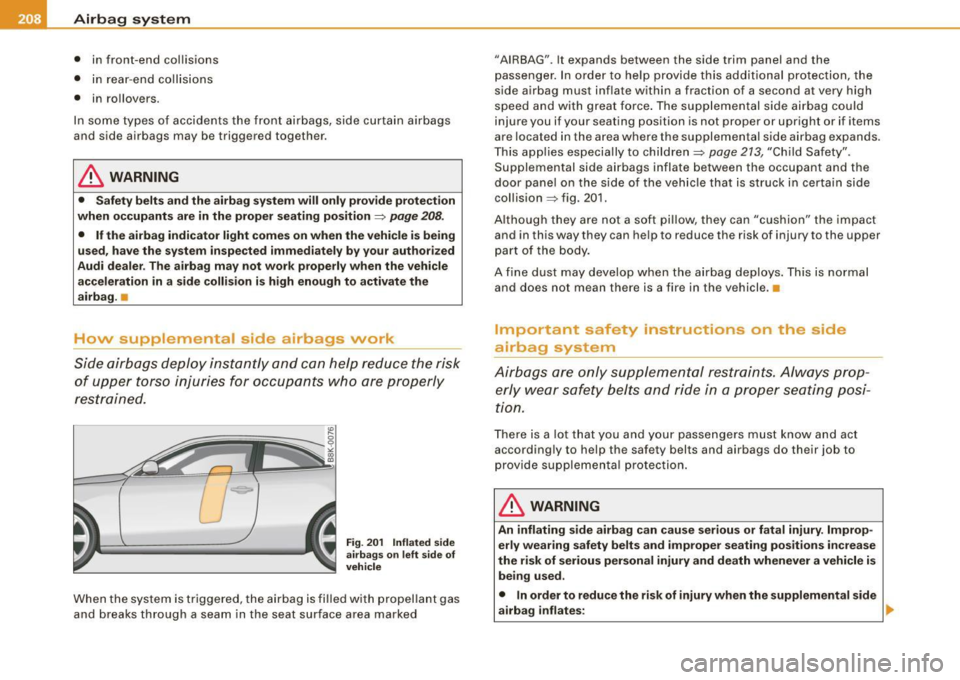
___ A_ ir_b _a_ g;:::;_ s--:.. y_s _t _e _m _________________________________________________ _
• in front-end collisions
• in rear-end collisions
• in rollovers.
In some types of accidents the front airbags, side curtain airbags
and side airbags may be triggered together.
& WARNING
• Safety belts and the airbag system will only provide protection
when occupants are in the proper seating position
=> page 208.
• If the airbag indicator light comes on when the vehicle is being
used, have the system inspected immediately by your authorized
Audi dealer . The airbag may not work properly when the vehicle
acceleration in a side collision is high enough to activate the
airbag. •
How supplemental side airbags work
Side airbags deploy instantly and can help reduce the risk
of upper torso injuries for occupants who are properly
restrained.
Fig . 201 Inflated side
airbags on left side of
vehicle
When the system is triggered, the airbag is filled with propellant gas
and breaks through a seam in the seat surface area marked "
AIRBAG ". It expands between the side trim panel and the
passenger. In order to help provide this additional protection, the
side airbag must inflate within a fraction of a second a t very high
speed and with great force. The supplemental side airbag could
injure you if your seating position is not proper or upright or if items
are located in the area where the supplemental side airbag expands.
This applies especially to children=>
page 213, "Child Safety".
Supplemental side airbags inflate between the occupant and the
door panel on the side of the vehicle that is struck in certain side
collision => fig. 201.
Although they are not a soft pillow, they can "cushion" the impact
and in this way they can help to reduce the risk of injury to the upper
part of the body.
A fine dust may develop when the airbag deploys. This is normal
and does not m ean there is a fire in the vehicle .•
Important safety instructions on the side
airbag system
Airbags are only supplemental restraints. Always prop
erly wear safety belts and ride in a proper seating posi
tion.
There is a lot that you and your passengers must know and act
accordingly to help the saf ety bel ts and airbags do their job to
provide supplemental protection.
& WARNING
An inflating side airbag can cause serious or fatal injury. Improp
erly wearing safety belts and improper seating positions increase
the risk of serious personal injury and death whenever a vehicle is
being used.
• In order to reduce the risk of injury when the supplemental side
airbag inflates:
~
Page 213 of 360
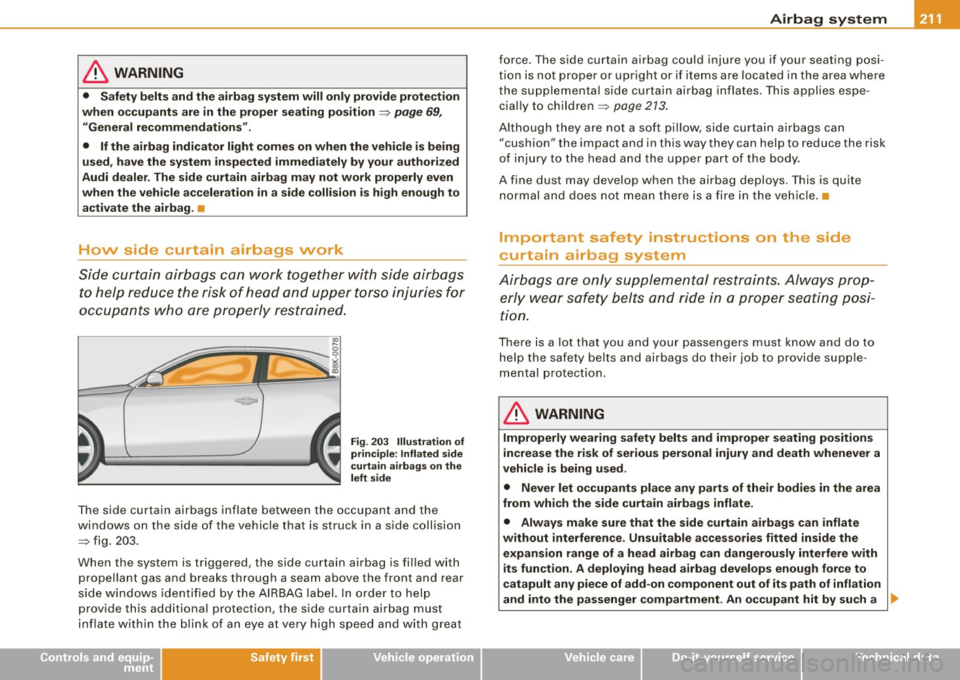
Airbag system -----------------=~-
& WARNING
• Safety belts and the airbag system will only provide protection
when occupants are in the proper seating position
~ page 69,
"General recommendations" .
• If the airbag indicator light comes on when the vehicle is being
used, have the system inspected immediately by your authorized
Audi dealer. The side curtain airbag may not work properly even
when the vehicle acceleration in a side collision is high enough to
activate the airbag. •
How side curtain airbags work
Side curtain airbags can work together with side airbags
to help reduce the risk of head and upper torso injuries for
occupants who are properly restrained.
..
Fig . 203 Illustration of
principle: Inflated side
curtain airbags on the
left side
The side curtain airbags inflate between the occupant and the
windows on the side of the vehicle that is struck in a side collision
~ fig. 203.
When the system is triggered, the side curtain airbag is filled with propellant gas and breaks through a seam above the front and rear
side windows identified by the AIRBAG label. In order to help
provide this additional protection, the side curtain airbag must
inflate within the blink of an eye at very high speed and with great
Controls and equip ment Safety first Vehicle operation force. The side curtain airbag could injure you if your seating posi
tion
is not proper or upright or if items are located in the area where
the supplemental side curtain airbag inflates. This applies espe
cially to children ~ page 213.
Although they are not a soft pillow, side curtain airbags can
"cushion" the impact and in this way they can help to reduce the risk
of injury to the head and the upper part of the body.
A fine dust may develop when the airbag deploys. This is quite
normal and does not mean there is a fire in the vehicle. •
Important safety instructions on the side
curtain airbag system
Airbags are only supplemental restraints. Always prop
erly wear safety belts and ride in a proper seating posi
tion.
ihere is a lot that you and your passengers must know and do to
help the safety belts and airbags do their job to provide supple
mental protection .
& WARNING
Improperly wearing safety belts and improper seating positions
increase the risk of serious personal injury and death whenever a
vehicle is being used.
• Never let occupants place any parts of their bodies in the area
from which the side curtain airbags inflate.
• Always make sure that the side curtain airbags can inflate
without interference. Unsuitable accessories fitted inside the
expansion range of a head airbag can dangerously interfere with
its function. A deploying head airbag develops enough force to
catapult any piece of add-on component out of its path of inflation
and into the passenger compartment. An occupant hit by such a _,.
Vehicle care Do-it-yourself service Technical data
Page 215 of 360
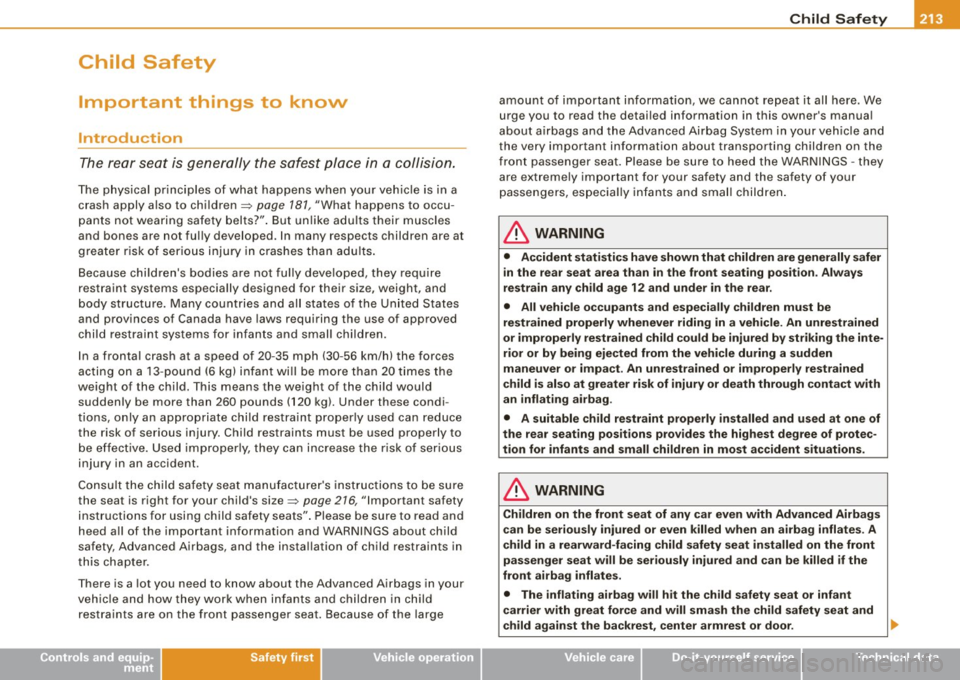
Child Safety -
--------------------''---
Child Safety
Important things to know
Introduction
The rear seat is generally the safes t place in a collision.
The p hysica l pr inciples of what happens when you r veh ic le is in a
crash apply also to children=>
page 181, "What happens to occu
pa nts not wearing safety bel ts?" . But un like adults their muscles
and bones are not ful ly developed. In many respects children are at
greater ris k of ser iou s injury in c rashes than adu lts .
B ecause chi ldren's bodies a re no t fully deve loped, they require
restraint systems especial ly designed for their size, weight, and
body structu re. Ma ny countries and al l sta tes of the U nited States
and provinces of Canada have laws requiring the use of approved
chil d restraint sys te m s for infa nts and s mall children .
I n a frontal crash at a speed of 20 -35 mph (30 -56 km/h) the forces
ac ting on a 13-pou nd (6 kg) infant wi ll be mo re than 20 times the
weight of the child. This means the weight of the child would
suddenly be more than 260 pounds ( 120 kg). Under these condi
t ions, only an appropriate child restraint proper ly used can reduce
the risk of serious in jury. Child restraints must be used proper ly to
b e e ffec tive. Use d improper ly, th ey can inc rease th e risk o f ser ious
injury in an accident .
Co nsul t the c hild safety seat man ufacture r's ins truc tions to be su re
the seat is right for your child's size=>
page 216, "Important safety
instructions for using child safety seats" . Please be sure to read and
heed a ll of the important information and WARNI NGS about child
safety, Advanced Airbags, and the insta llation of child restraints in
this chapter.
T here is a lot you need to know about the Advanced Airbags in your
veh ic le and how they work whe n inf an ts and ch ild ren in c hild
restraints are on the front passenger seat. Because of the large
Controls and equip ment Safety first Vehicle operation
amoun
t of important informat ion, we cannot repeat it all here. We
urge you to read the detai led information in this owner's manua l
about a irbags and the Advanced Airbag Sys tem in your ve hic le and
the very important information about transporting children on the
fr ont passenger sea t. Please b e sure to hee d th e WAR NINGS -they
are extreme ly important for your safety and the safety of your
p asse ngers, es pecia lly inf ant s and s mall ch ildren .
& WARNING
• Accident statistics have shown that children are generally safer
in the rear seat area than in the front seating position . Always
restrain any child age 12 and under in the rear.
• All vehicle o ccupants and especially children must be
restrained properly whenever riding in a vehicle . An unrestrained
or improperly restrained child could be injured by striking the inte
rior or by being ejected from the vehicle during a sudden
maneuver o r impact . An unrestrained or improperly restrained
c hild is also at greater risk of injury or death through contact with
an inflating a irbag .
• A suitable child restraint properly installed and used at one of
the rear seating positions provides the highest degree of protec
tion for infants and small children in most accident situations .
& WARNING
Children on the front seat of any car even with Advanced Airb ags
c an be seriously injured or even killed when an airbag inflates . A
child in a rearward -fa cing child safety seat installed on the front
passenger seat will be seriously injured and can be killed if the
front airbag inflates.
• The inflating airbag will hit the ch ild safety seat or infant
carrier with great force and will smash the child safety seat and
child against the backrest , center armrest or door. •
Vehicle care Do-it-yourself service Technical data
Page 216 of 360
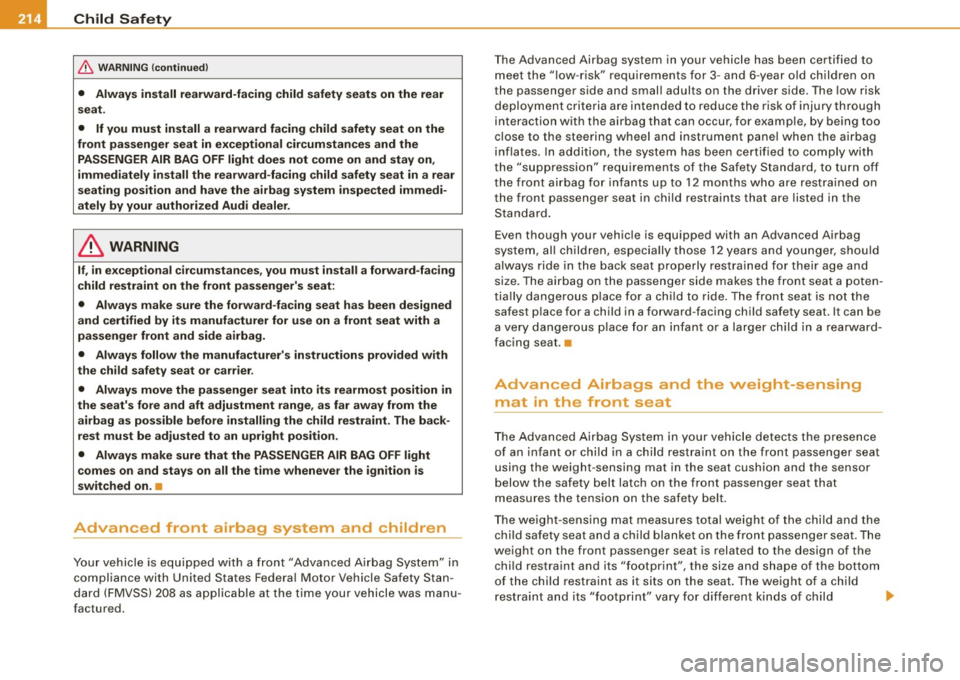
-Child Safety ------=---------------------------------
& WAR NIN G (co ntinued )
• Alw ays inst all r ear ward-f acing child safet y sea ts on the r ear
s eat.
• If you must in stall a r earward facing child saf ety seat on the
front p assenger seat in e xcept ion al circum sta nce s and the
PASSENGER AIR BAG OFF light doe s not come on and stay on ,
imm edi atel y ins ta ll the re arw ard -fa cin g child safety seat in a re ar
s eating po sit ion and have the airb ag s ystem inspe cted immedi
a tely by your autho rized Audi dealer .
& WARNING
If, in e xce ptional cir cum sta nces, you mu st in stall a fo rward-fa cing
c hild restraint on the front p asseng er's seat :
• Alway s m ake s ure the forw ard -fa cing seat h as been de signed
and cert ified by its manufacturer for use on a front seat with a
passenger front and side airbag.
• Alway s follow the m anufacturer's instructi on s provided with
the child s afety seat or carrier .
• Alway s move the p assenger seat into it s rearmo st position in
the seat's fo re and aft adju stment range , as far a way from the
airbag a s po ssible b efore in stalling the child restraint. The ba ck
rest must be adjusted t o an up rig ht position .
• Alway s m ake sure that the PA SSENG ER AIR BAG OFF light
c ome s on and stays on all the time whenever the ign iti on is
switched on. •
Advanced front airbag system and children
Your vehicle is equipped with a front "Advanced Airbag System" in
compliance with United States Federa l Motor Vehicle Safety Stan
dard (FMVSS) 208 as applicable at the time your vehicle was manu
factured . T
he Advanced Airbag system in your vehicle has been certified to
meet the " low -risk" requiremen ts for 3 -and 6 -year o ld children on
the passenger side and smal l adults on the driver side . The low risk
deployment criteria are intended to reduce the risk of injury through
interaction with the airbag that can occur , for example, by being too
close to the steering wheel and instrument panel when the airbag
inflates. In addition, the system has been certified to comply with
the "suppression" requirements of the Safety Standard, to turn off
the front airbag for infants up to 12 months who are restrained on
the front passenger seat in child restraints that are listed in the
S tandard.
Even though your vehicle is equipped with an Advanced Airbag
system, all ch ildren, especially those 12 years and younge r, should
always ride in the back seat properly restrained for their age and
size . The airbag on the passenger side makes the front seat a poten
tially dangerous p lace for a child to ride. The front seat is not the
safest p lace for a child in a forward -facing child safety seat . It can be
a very dangerous p lace for an infant or a larger ch ild in a rearward
facing seat. •
Advanced Airbags and the weight-sensing
mat in the front seat
The Advanced Airbag System in your vehicle detects the presence
of an infant or child in a chi ld restraint on the front passenger seat
using the weight -sensing mat in the seat cushion and the sensor
below the safety belt latch on the front passenger seat that
measures the tension on the safety belt.
The weight -sensing mat measures total weight of the chi ld and the
child safety seat and a child blanket on the front passenger seat . The
weight on the front passenger seat is related to the design of the
child restraint and its "footprint", the size and shape of the bottom
of the child restraint as it sits on the seat . The weight of a child
restraint and its "footprint" vary for different kinds of child ..,.
Page 218 of 360
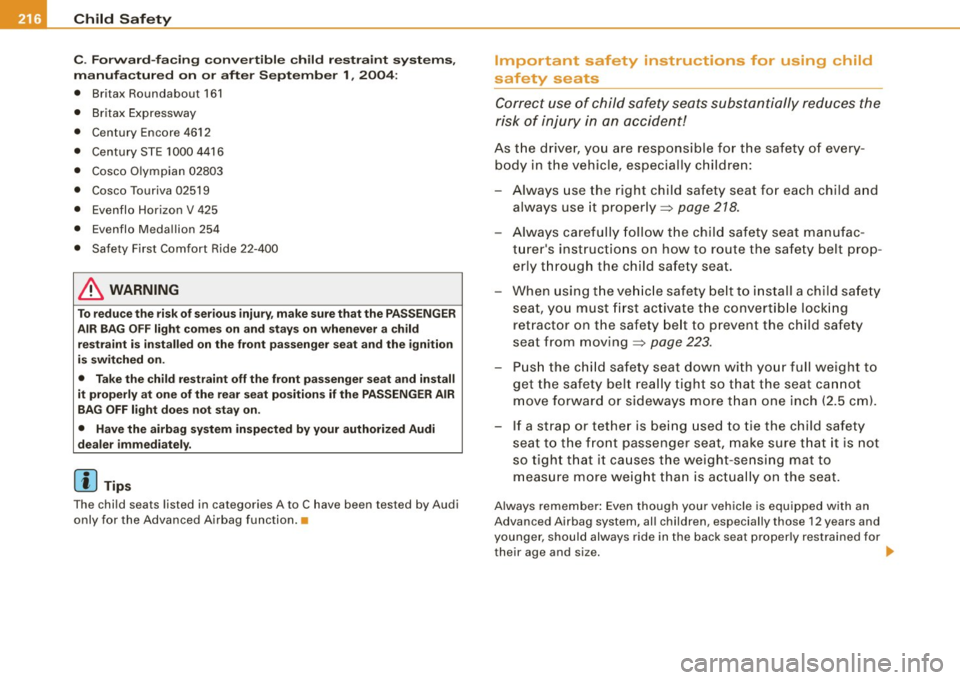
___ C_h_ i_ ld _ S_ a_ f_ e_ t_y ____________________________________________ _
C. Forward-facing convertible child restraint systems,
manufactured on or after September 1, 2004:
• Britax Roundabout 161
• Britax Expressway
• Century Encore 4612
• Century STE 1000 4416
• Cosco Olympian 02803
• Cosco Touriva 02519
• Evenflo Horizon V 425
• Evenflo Medallion 254
• Safety First Comfort Ride 22-400
& WARNING
To reduce the risk of serious injury, make sure that the PASSENGER
AIR BAG OFF light comes on and stays on whenever a child
restraint is installed on the front passenger seat and the ignition
is switched on.
• Take the child restraint off the front passenger seat and install
it properly at one of the rear seat positions if the PASSENGER AIR
BAG OFF light does not stay on.
• Have the airbag system inspected by your authorized Audi
dealer immediately.
[ i] Tips
The child seats listed in categories A to C have been tested by Audi
only for the Advanced Airbag function. •
Important safety instructions for using child
safety seats
Correct use of child safety seats substantially reduces the
risk of injury in an accident!
As the driver, you are responsible for the safety of every
body in the vehicle, especially children:
- Always use the right child safety seat for each child and
always use it properly ::::>
page 218.
-Always carefully follow the child safety seat manufac
turer's instructions on how to route the safety belt prop
erly through the child safety seat.
- When using the vehicle safety belt to install a child safety
seat, you must first activate the convertible locking
retractor on the safety belt to prevent the child safety
seat from moving ::::>
page 223.
-Push the child safety seat down with your full weight to
get the safety belt really tight so that the seat cannot
move forward or sideways more than one inch (2.5 cm).
- If a strap or tether is being used to tie the child safety
seat to the front passenger seat, make sure that it is not
so tight that it causes the weight-sensing mat to
measure more weight than is actually on the seat.
Always remember: Even though your vehicle is equipped with an
Advanced Airbag system, all children, especially those 12 years and
younger, should always ride in the back seat properly restrained for
their age and size. _,,
Page 219 of 360

_____________________________________________ C_ h _ il_d _S_ a _ fe_t---= y'---_fflllll
& WARNING
Not using a child safety seat, using the wrong child safety seat or
improperly installing a child restraint increases the risk of serious
personal injury and death .
• All vehicle occupants and especially children must always be
restrained properly whenever riding in a vehicle .
- An unrestrained or improperly restrained child can be injured or killed by being thrown against the inside of the vehicle or by
being ejected from it during a sudden maneuver or impact.
- An unrestrained or improperly restrained child is at much
greater risk of injury or death by being struck by an inflating
airbag.
• Commercially available child safety seats are required to
comply with U .S . Federal Motor Vehicle Safety Standard (FMVSSl
213 (in Canada CMVSS 213).
-When buying a child restraint, select one that fits your child
and the vehicle.
- Only use child restraint systems that fully contact the flat
portion of the seat cushion. The child restraint must not tip or
lean to either side . Audi does not recommend using child safety
seats that rest on legs or tube-like frames. They do not provide
adequate contact with the seat .
- Always heed all legal requirements pertaining to the installa
tion and use of child safety seats and carefully follow the
instructions provided by the manufacturer of the seat you are
using .
• Never allow children under 57 inches {1 .5 meters) to wear a
normal safety belt. They must always be restrained by a proper
child restraint system. Otherwise, they could sustain injuries to
the abdomen and neck areas during sudden braking maneuvers or
accidents.
• Never let more than one child occupy a child safety seat .
Controls and equip ment Safety first
Vehicle operation
& WARNING (continued)
• Never let babies or older children ride in a vehicle while sitting
on the lap of another passenger .
- Holding a child in your arms is never a substitute for a child
restraint system .
- The strongest person could not hold the child with the forces
that exist in an accident. The child will strike the interior of the
vehicle and can also be struck by the passenger.
- The child and the passenger can also injure each other in an
accident.
• Never install rearward-facing child safety seats or infant
carriers on the front passenger seat. A child will be seriously
injured and can be killed when the passenger airbag inflates -
even with an Advanced Airbag System. -The inflating airbag will hit the child safety seat or infant
carrier with great force and will smash the child safety seat and
child against the backrest, door or roof .
- Always install rearward -facing child safety seats or infant
carriers on the rear seat .
• Forward -facing child safety seats installed on the front
passenger's seat can interfere with the airbag when it inflates and
cause serious injury to the child. Always install forward -facing
child safety seats on the rear seat .
• If exceptional circumstances require the use of a forward
facing child restraint on the front passenger's seat , the child's
safety and well-being require that the following special precau
tions be taken :
- Make sure the forward -facing seat has been designed and
certified by its manufacturer for use on a front seat with a
passenger front and side airbag.
- Always carefully follow the manufacturer's instructions
provided with the child safety seat or carrier.
Vehicle care Do-it-yourself service Technical data